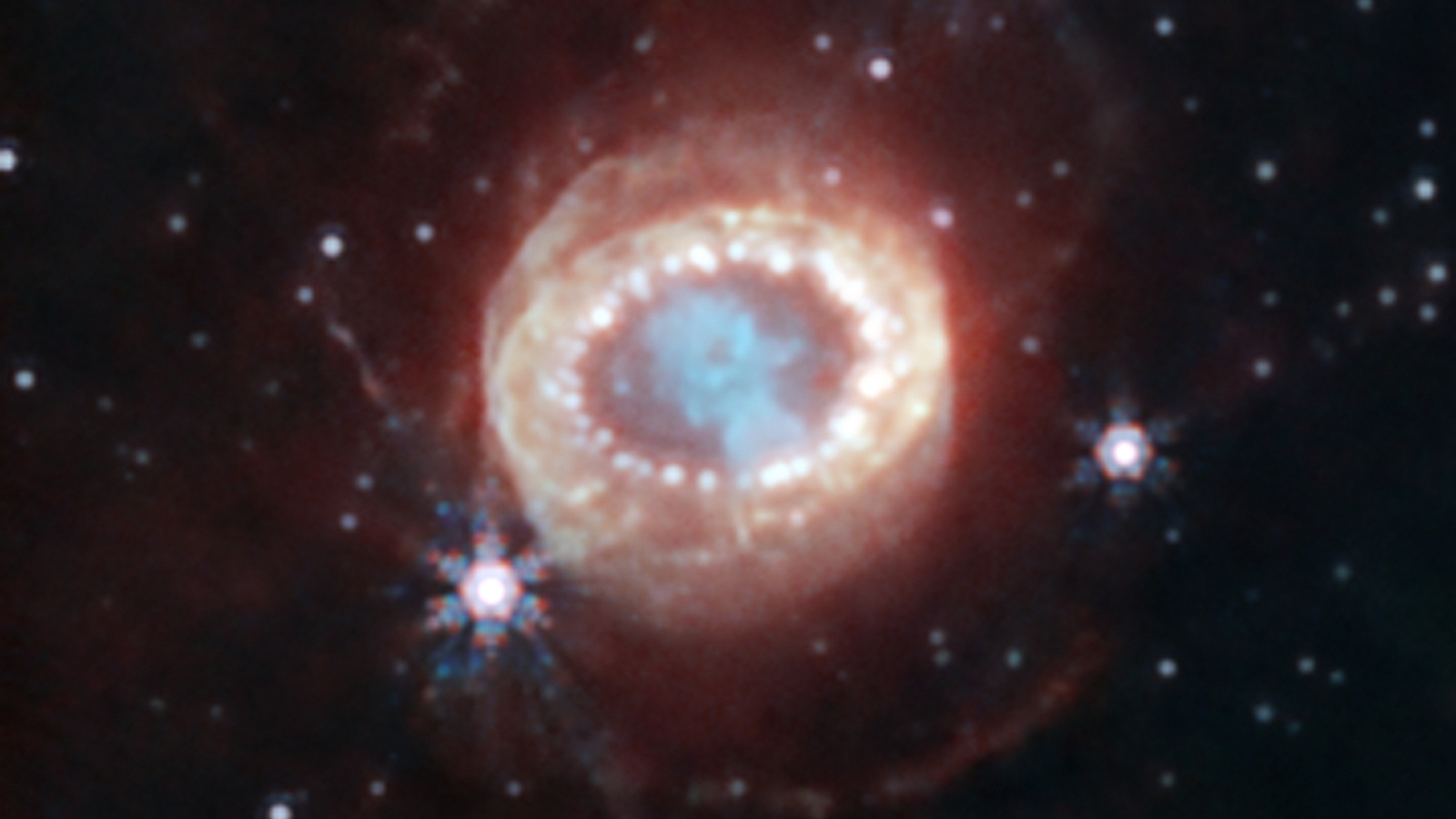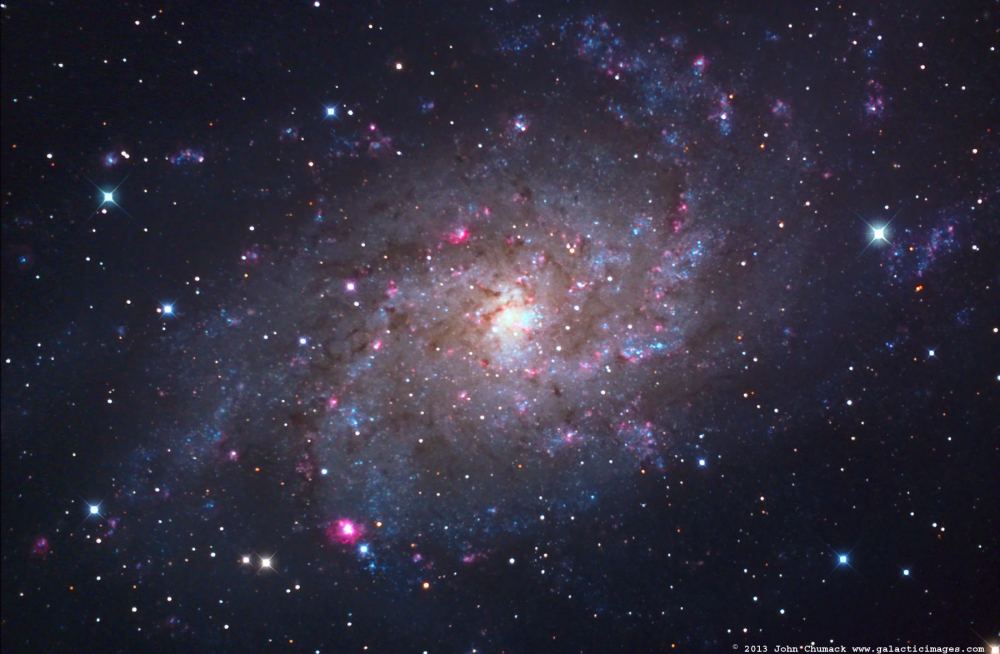Lots of things out in the Universe can cause a supernova, from the gravitational collapse of a massive star, to the collision of white dwarfs. But most of the supernovae we observe are in other galaxies, too distant for us to see the details of the process. So, instead, we categorize supernovae by observed characteristics such as the light curves of how they brighten and fade and the types of elements identified in their spectra. While this gives us some idea of the underlying cause, there are still things we don’t entirely understand. This is particularly true for one particular kind of supernova known as Type Ia.
Continue reading “Do We Really Know What Becomes a Type Ia Supernova?”A Nearby Supernova Could Finally Reveal Dark Matter

Despite 90 years of research, the nature and influence of Dark Matter continue to elude astronomers and cosmologists. First proposed in the 1960s to explain the rotational curves of galaxies, this invisible mass does not interact with normal matter (except through gravity) and accounts for 85% of the total mass in the Universe. It is also a vital component in the most widely accepted cosmological model of the Universe, the Lambda Cold Dark Matter (LCDM) model. However, according to new research, the hunt for DM could be over as soon as a nearby star goes supernova.
Currently, the axion is considered the most likely candidate for DM, a hypothetical low-mass particle proposed in the 1970s to resolve problems in quantum theory. There has also been considerable research into how astronomers could detect axions by observing neutron stars and objects with powerful magnetic fields. In a recent study supported by the U.S. Department of Energy, a team of astrophysicists at the University of California Berkeley argued that axions could be discovered within seconds of detecting gamma rays from a nearby supernova explosion.
Continue reading “A Nearby Supernova Could Finally Reveal Dark Matter”The First Close-Up Picture of Star Outside the Milky Way

Like a performer preparing for their big finale, a distant star is shedding its outer layers and preparing to explode as a supernova.
Astronomers have been observing the huge star, named WOH G64, since its discovery in the 1970s. It’s one of the largest known stars, and also one of the most luminous and massive red supergiants (RSGs). The star is surrounded by an envelope of expelled star-stuff, which could indicate it’s getting ready to explode.
Continue reading “The First Close-Up Picture of Star Outside the Milky Way”A Star Disappeared in Andromeda, Replaced by a Black Hole

Massive stars about eight times more massive than the Sun explode as supernovae at the end of their lives. The explosions, which leave behind a black hole or a neutron star, are so energetic they can outshine their host galaxies for months. However, astronomers appear to have spotted a massive star that skipped the explosion and turned directly into a black hole.
Continue reading “A Star Disappeared in Andromeda, Replaced by a Black Hole”Learning More About Supernovae Through Stardust

Most of the diverse elements in the Universe come from supernovae. We are, quite literally, made of the dust of those long-dead stars and other astrophysical processes. But the details of how it all comes about are something astronomers strive to understand. How do the various isotopes produced by supernovae drive the evolution of planetary systems? Of the various types of supernovae, which play the largest role in creating the elemental abundances we see today? One way astronomers can study these questions is to look at presolar grains.
Continue reading “Learning More About Supernovae Through Stardust”This Ancient Supernova Remnant Looks Like a Stellar Dandelion

In 1181, Japanese and Chinese astronomers saw a bright light appear in the constellation Cassiopeia. It shone for six months, and those ancient observers couldn’t have known it was an exploding star. To them, it looked like some type of temporary star that shone for 185 days.
In the modern astronomical age, we’ve learned a lot more about the object. It was a supernova called SN 1181 AD, and we know that it left behind a remnant “zombie” star. New research examines the supernova’s aftermath and the strange filaments of gas it left behind.
Continue reading “This Ancient Supernova Remnant Looks Like a Stellar Dandelion”Webb Finds Dozens of Supernovae Remnants in the Triangulum Galaxy

Infrared astronomy has revealed so much about the Universe, ranging from protoplanetary disks and nebulae to brown dwarfs, aurorae, and volcanoes on together celestial bodies. Looking to the future, astronomers hope to conduct infrared studies of supernova remnants (SNRs), which will provide vital information about the physics of these explosions. While studies in the near-to-mid infrared (NIR-MIR) spectrum are expected to provide data on the atomic makeup of SNRs, mid-to-far IR (MIR-FIR) studies should provide a detailed look at heated dust grains they eject into the interstellar medium (ISM).
Unfortunately, these studies have been largely restricted to the Milky Way and the Magellanic Clouds due to the limits of previous IR observatories. However, these observational regimes are now accessible thanks to next-generation instruments like the James Webb Space Telescope (JWST). In a recent study, a team led by researchers from Ohio State University presented the first spatially resolved infrared images of supernova remnants (SNRs) in the Triangulum Galaxy (a.k.a. Messier 33). Their observations allowed them to acquire images of 43 SNRs, thanks to the unprecedented sensitivity and resolution of Webb’s IR instruments.
Continue reading “Webb Finds Dozens of Supernovae Remnants in the Triangulum Galaxy”How a Nearby Supernova Left its Mark on Earth Life

When a massive star explodes as a supernova, it does more than release an extraordinary amount of energy. Supernovae explosions are responsible for creating some of the heavy elements, including iron, which is blasted out into space by the explosion. On Earth, there are two accumulations of the iron isotope Fe60 in sea-floor sediments that scientists trace back about two or three million years ago and about five to six million years ago.
The explosions that created the iron also dosed Earth with cosmic radiation.
Continue reading “How a Nearby Supernova Left its Mark on Earth Life”Only Hubble Could Make this Measurement of a Supernova
Calculating the distance to far-away objects, such as galaxy clusters and quasars, is difficult. But it is also critical to our understanding of how the universe evolves. Luckily, humanity has a trusty workhorse that has been collecting data for such calculations for decades—Hubble. It is by far the best telescope suited to the job, as described by a recent NASA press release about a distance measurement to a supernova in a nearby galaxy.
Continue reading “Only Hubble Could Make this Measurement of a Supernova”Supernovae: Why study them? What can they teach us about finding life beyond Earth?
Universe Today has recently investigated a myriad of scientific disciplines, including impact craters, planetary surfaces, exoplanets, astrobiology, solar physics, comets, planetary atmospheres, planetary geophysics, cosmochemistry, meteorites, radio astronomy, extremophiles, organic chemistry, black holes, cryovolcanism, planetary protection, and dark matter, and what they can teach us about how we got here, where we’re going, and whether we might find life elsewhere in the universe.
Here, Universe Today discusses the explosive field of supernovae—plural for supernova—with Dr. Joseph Lyman, who is an assistant professor in the Astronomy and Astrophysics Group at the University of Warwick, regarding the importance of studying supernovae, the benefits and challenges, the most intriguing aspects about supernovae he’s studied throughout his career, what supernovae can teach us about finding life beyond Earth, and any advice he can offer upcoming students who wish to pursue studying supernovae. Therefore, what is the importance of studying supernovae?
Continue reading “Supernovae: Why study them? What can they teach us about finding life beyond Earth?”


